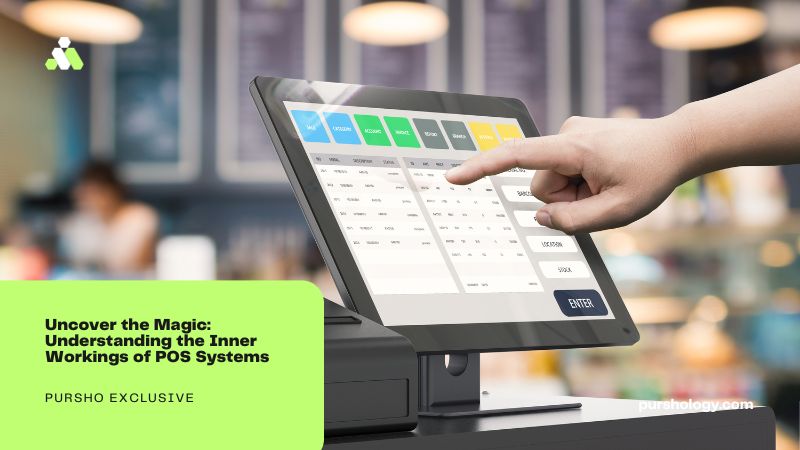Unlock the secrets behind modern-day sorcery: Dive into the mind-bending mechanics of POS systems and reveal their enchanting powers!

What Exactly is a Point of Sale (POS) System?
A Point of Sale (POS) system is the central nervous system of a retail or service-based business. It is where the transaction between the business and the customer takes place.
A typical POS system consists of a combination of hardware components such as a cash register, barcode scanner, receipt printer, and software components like transaction processing, inventory management, and reporting. These elements work together to ensure smooth and efficient customer transactions.
Behind the Scenes: The Intricate Workflow of POS Systems
Ever wondered about the sequence of events that lead to a successful transaction? Let’s pull back the curtain and understand the intricate workflow of a POS system:
1. Capturing Item Details
The first step involves capturing the details of the items being purchased. This is typically done through barcode scanning, manual entry, or using RFID technology. Each item has a unique barcode that the scanner reads, instantly retrieving its price and other relevant information from the system.
2. Calculating Prices and Taxes
Once the items have been identified, the system calculates the final price, taking into account any discounts, promotions, or tax rules that may apply. This ensures accurate and transparent pricing for the customer.
3. Processing Payment Methods
Now comes the exciting part – paying for your purchase! The POS system offers various payment options, including cash, credit cards, and mobile payments. It securely processes the chosen payment method and generates a receipt for the customer.
4. Updating Inventory in Real-Time
One of the crucial functions of a POS system is inventory management. After each transaction, the POS system updates the inventory in real-time, ensuring accurate stock levels. This allows businesses to monitor their inventory and generate alerts for restocking when necessary.
5. Generating a Receipt and Providing Post-Sales Services
Finally, the POS system generates a receipt for the customer, listing the items purchased, their prices, and any applicable discounts or taxes. Furthermore, the system may also provide post-sales services such as loyalty program updates or warranty registration.
The Power of CRM Integration: Enhancing Billing and Beyond
While POS systems handle transactions, Customer Relationship Management (CRM) systems focus on nurturing customer relationships. However, integrating CRM with your POS billing system offers numerous benefits:
Merging Customer Profiles for Streamlined Interactions
By integrating CRM with your POS system, you can consolidate customer purchase histories, preferences, and contact information. This provides a comprehensive view of each customer, allowing your business to personalize interactions and offer tailored product suggestions or promotions.
Unlocking Personalized Customer Experiences
Tracking customer purchase behavior is another advantage of CRM integration. By studying buying patterns and preferences, you can create targeted marketing campaigns and offers that resonate with individual customers. This personalization enhances the overall customer experience, fostering loyalty and encouraging repeat purchases.
Fostering Customer Loyalty and Retention Through Targeted Marketing
With a CRM integrated into your POS system, you can create and manage customer loyalty programs more effectively. The system can automatically track points, rewards, and redemption, ensuring a seamless experience for both your business and the customers. In addition, you can send targeted marketing communications to specific customer segments, nurturing loyalty and maximizing customer lifetime value.
Choosing the Right POS System with CRM Integration
Now that you understand the power of integrating CRM with your POS system, let’s discuss the key factors to consider when choosing the right solution:
Evaluate Your Business Needs and Goals
Before making a decision, assess your business requirements and objectives. Consider factors such as the type and size of your business, the volume of transactions you handle, and scalability for future growth.
Research POS Software Solutions with CRM Integration
Investigate various POS software solutions to identify those that offer seamless CRM integration capabilities. Look for providers who have a proven track record in both areas and offer a user-friendly interface that meets your business needs.
Confirm Seamless Data Synchronization
Ensure that the POS system and CRM software can synchronize data seamlessly. This synchronization allows for real-time updates, preventing any data discrepancies and ensuring a smooth flow of information between the two systems.
Compatibility with Existing Infrastructure
If you have an existing hardware or software infrastructure, it is crucial to ensure that the chosen POS system and CRM software are compatible. Consider factors such as operating systems, integration capabilities, and potential customization requirements.
Scalability and Future Growth
Finally, choose a POS system with CRM integration that can scale with your business as it grows. Look for solutions that can handle increased transaction volumes, support multiple locations, and accommodate additional features and functionalities.
In Conclusion
The world of POS systems might seem complex at first, but understanding their inner workings can unlock a wealth of benefits for your business. By integrating CRM with your POS billing system, you can streamline customer interactions, personalize experiences, and foster long-term loyalty. Remember to choose a POS system with CRM integration carefully, ensuring it aligns with your business needs and future growth plans. Embrace the magic of POS systems and elevate your business to new heights.







